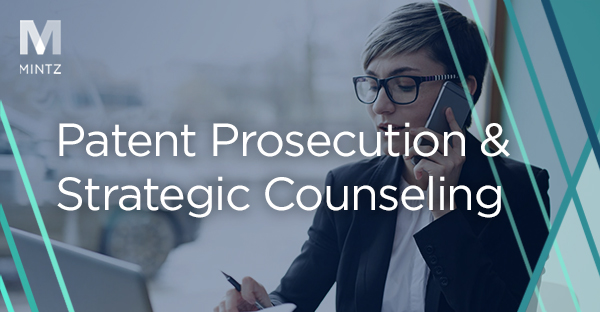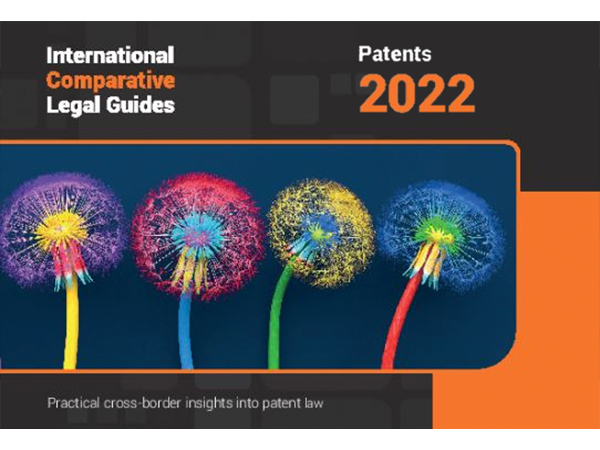
Intellectual Property
Viewpoints
Filter by:
Expediting Patent Prosecution with the New Collaborative Search Pilot Program
August 7, 2015 | Blog | By Christina Sperry
Two new Collaboration Search Pilot Programs are or will soon be available to patent applicants. The Collaboration Search Pilot Program (CSP) between the United States Patent and Trademark Office (USPTO) and the Japan Patent Office (JPO) is available as of August 1, 2015.
Read more
Federal Circuit Clarifies Standard for Prior Art in Obviousness Analysis
July 31, 2015 | Blog | By Nick Armington, William Meunier
Earlier this week, the Federal Circuit in Circuit Check Inc. v. QXQ, Inc. clarified the standard by which a reference may be considered prior art for the purposes of an obviousness determination.
Read more
PTAB Issues Representative Order Clarifying Motion to Amend Analysis in Idle Free Systems
July 21, 2015 | Blog | By Brad M Scheller
Yesterday the Patent Trial and Appeal Board (“Board”) added a recent order to its list of Representative Orders, Decisions, and Notices.
Read more
ITC Sheds Light on Economic Prong of Domestic Industry Under Subsection 337(a)(3)(C) and Issues General Exclusion Order
July 6, 2015 | Blog
On June 26, 2015, the ITC handed down its Commission Opinion in Certain Loom Kits for Creating Linked Articles, Inv. No. 337-TA-923, Comm’n Op. (Feb. 3, 2015) (hereinafter “Loom Kits ”), granting a general exclusion order.
Read more
Federal Circuit Affirms Dismissal on Grounds of Patent Ineligibility
July 1, 2015 | Blog | By Michael Van Loy, Monique Winters Macek
On June 23, 2015, the Federal Circuit affirmed the finding of the U.S. District Court for the Northern District of California (“District Court”) dismissing the complaints in four related actions for infringement of U.S. Patent No. 7,707,505 (the ‘505 Patent) on the ground of patent ineligibility under 35 U.S.C. §101.
Read more
The Federal Circuit Alters the Means-Plus-Function Analysis
July 1, 2015 | Blog | By William Meunier
The Federal Circuit’s recent en banc opinion in Williamson v. Citrix Online, LLC, 2015 U.S. App. LEXIS 10082, *2 (Fed. Cir. June 16, 2015) (Williamson II) may result in courts finding that more claims include “means-plus-function” claim elements, which could significantly affect the scope and validity of those claims.
Read more
Crowdfunding and IP in Health and Biotech Start-ups (Part 3): Potential Dangers
June 29, 2015 | Blog | By Lisa Adams
PART III: First, the JOBS Act requires the SEC to issue complex implementing rules prior to crowdfunding becoming a reality. For any startup seeking funding through a crowdfunding source, the rules proposed by the SEC under the Act demand detailed disclosures regarding the company. The company must also describe exactly how the securities it is offering are being valued.
Read more
Crowdfunding and IP in Health and Biotech Start-ups (Part 2): The JOBS Act
June 25, 2015 | Blog | By Lisa Adams
PART 2: he US government began to address these investment challenges through the Jumpstart Our Business Startups Act (JOBS Act) in April 2012. While companies like Kickstarter allow startups to sell products or services, the JOBS Act envisions companies actually selling equity in themselves through crowdfunding campaigns.
Read more
Newsflash, Politico: 'Patent Death Squad' Alive and Well
June 24, 2015 | Blog | By Michael McNamara
Politico, the popular political journalism publication, recently ran the story “Patent Reform Advocates: PTO Process Not Patent ‘Death Squad.’” The story was based on a blog post by patent reform advocate Unified Patents.
Read more
Fed Circuit Reverses PTAB Decision in IPR Proceeding
June 22, 2015 | Blog | By Arun K. Goel, Brad M Scheller
On June 16, the Federal Circuit issued its first-ever reversal of a Patent Trial and Appeal Board decision in an America Invents Act post-grant proceeding. The opinion, drafted by Chief Judge Prost and joined by CAFC Judge Lourie and E.D. Tex. Judge Gilstrap, provides considerable guidance on claim construction and claim amendments in practice before the PTAB.
Read more
New USPTO Expedited Patent Appeal Pilot Program
June 19, 2015 | Blog | By Christina Sperry, Brad M Scheller
On June 15, 2015, the United States Patent and Trademark Office (“USPTO”) issued Notice in the Federal Register announcing a new pilot program, the Expedited Patent Appeal Pilot.
Read more
Crowdfunding and IP in Health and Biotech Start-ups (Part 1): The Beginning
June 18, 2015 | Blog | By Lisa Adams
PART 1: Pebble Technology had an interesting goal. It wanted to design and build a watch that could connect to iPhone and Android smartphones using Bluetooth. It wanted to allow the watch to alert a wearer with a silent vibration for incoming calls, emails and messages.
Read more
FRAND Defense: ALJ Essex Provides an Evidence-Based Framework
June 16, 2015 | Blog | By Michael Renaud, Sandra Badin, Robert Moore
Administrative Law Judge Essex has made another important contribution to the ongoing conversation regarding the enforcement of standard essential patents (SEPs) at the International Trade Commission.
Read more
PTAB Grants Fourth Motion to Amend in an IPR Proceeding
June 16, 2015 | Blog | By Brad M Scheller
For only the fourth time in its history, the Patent Trial and Appeal Board (“PTAB”) has granted a motion to amend in an inter partes review (“IPR”) proceeding, finding all substitute claims proposed by the patent owner patentable.
Read more
Fed Circuit: Sequenom’s Diagnostic Method Claims Invalid Under §101
June 15, 2015 | Blog | By Terri Shieh-Newton
On June 12, 2015, in Ariosa Diagnostics, Inc. v. Sequenom, Inc., the Federal Circuit affirmed the Northern District of California’s finding that the method claims in U.S. Patent 6,258,540 (‘540 patent) for detecting paternally-inherited cell-free fetal DNA (“cffDNA”) in maternal plasma or serum were invalid because these claims were not directed to patent eligible subject matter (Ariosa Diagnostics, Inc. v. Sequenom, Inc., No. 2014-1139, 2014-1144 (Fed. Cir., June 12, 2015)).
Read more
D.C. Circuit Affirms: FTC Can Change HSR Rules Targeted at Pharmaceutical Patents
June 11, 2015 | Blog | By Dionne Lomax
In a confluence of IP and antitrust law, a three judge panel for the D.C. Circuit recently affirmed a lower court decision upholding the Federal Trade Commission’s (“FTC”) 2013 modification of regulations under the Hart Scott Rodino (“HSR”) Act to require reporting of even partial transfers of pharmaceutical patent rights as an “asset acquisition” if all commercially significant rights are transferred.
Read more
Second Circuit Holds "Hard Switch" Violates Sherman Act
June 4, 2015 | Blog
On May 22, 2015, in a much-watched case, the Second Circuit upheld a preliminary injunction against Actavis PLC and its wholly owned subsidiary, Forest Laboratories, LLC (collectively “Actavis” or “Forest”), finding that Actavis’s “hard switch” strategy to launch an extended-release version of its blockbuster Alzheimer’s therapy and de-list the immediate-release version would likely violate Section 2 of the Sherman Act.
Read more
The Federal Circuit’s First Foray into the BPCIA: “A Pulitzer Prize for Complexity"?
June 4, 2015 | Blog | By Thomas Wintner
Yesterday, a Federal Circuit panel comprising Judges Newman, Lourie, and Chen heard oral argument in Amgen Inc. v. Sandoz Inc. (Fed. Cir. No. 2015-1499), the first ever case requiring the Appeals Court to address the meaning of various provisions of the Biologics Price Competition and Innovation Act (BPCIA).
Read more
PTAB Issues 'Quick Fix' Rule Package, Effective Immediately
May 28, 2015 | Blog | By Brad M Scheller , Yogesh Patel
On March 31 we posted about the Patent Office rolling out a series of rulemakings for improving post-grant proceedings, beginning with a first rule package of “quick fixes” this spring.
Read more
"Restriction Requirements" Series, Part 1: Considering Restrictions When Developing a Claim Filing Strategy
May 19, 2015 | Blog | By Christina Sperry
Welcome to the blog’s first post in a series about restriction requirements! This series will explore nuances in restriction requirement law and provide strategies for most effectively handling restriction requirements, both before and after they arise during prosecution of a U.S. patent.
Read more
Explore Other Viewpoints:
- Antitrust
- Appellate
- Arbitration, Mediation & Alternate Dispute Resolution
- Artificial Intelligence
- Awards
- Bankruptcy & Restructuring
- California Land Use
- Class Action
- Complex Commercial Litigation
- Construction
- Consumer Product Safety
- Cross-Border Asset Recovery
- Debt Financing
- Direct Investing (M&A)
- Diversity
- EB-5 Financing
- Education & Nonprofits
- Employment
- Energy & Sustainability
- Environmental Enforcement Defense
- Environmental Law
- FDA Regulatory
- Federal Circuit Appeals
- Financial Institution Litigation
- Government Law
- Growth Equity
- Health Care
- Health Care Compliance, Fraud and Abuse, & Regulatory Counseling
- Health Care Enforcement & Investigations
- Health Care Transactions
- Health Information Privacy & Security
- IP Due Diligence
- IPRs & Other Post Grant Proceedings
- Immigration
- Insolvency & Creditor Rights Litigation
- Institutional Investor Class Action Recovery
- Insurance & Financial Services
- Insurance Consulting & Risk Management
- Insurance and Reinsurance Problem-Solving & Dispute Resolution
- Intellectual Property
- Investment Funds
- Israel
- Licensing & Technology Transactions
- Life Sciences
- Litigation & Investigations
- M&A Litigation
- ML Strategies
- Medicare, Medicaid and Commercial Coverage & Reimbursement
- Mergers & Acquisitions
- Patent Litigation
- Patent Prosecution & Strategic Counseling
- Pharmacy Benefits and PBM Contracting
- Portfolio Companies
- Privacy & Cybersecurity
- Private Client
- Private Equity
- Pro Bono
- Products Liability & Complex Tort
- Projects & Infrastructure
- Public Finance
- Real Estate Litigation
- Real Estate Transactions
- Real Estate, Construction & Infrastructure
- Retail & Consumer Products
- Securities & Capital Markets
- Securities Litigation
- Special Purpose Acquisition Company (SPACs)
- Sports & Entertainment
- Strategic IP Monetization & Licensing
- Tax
- Technology
- Technology, Communications & Media
- Technology, Communications & Media Litigation
- Trade Secrets
- Trademark & Copyright
- Trademark Litigation
- Value-Based Care
- Venture Capital & Emerging Companies
- White Collar Defense & Government Investigations
- Women's Health and Technology






